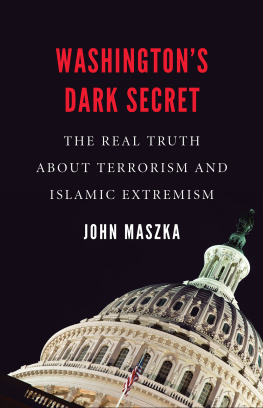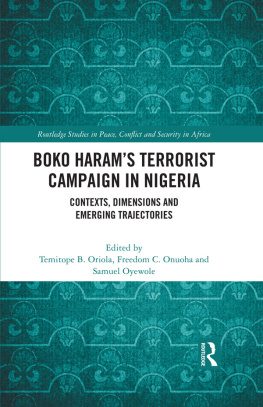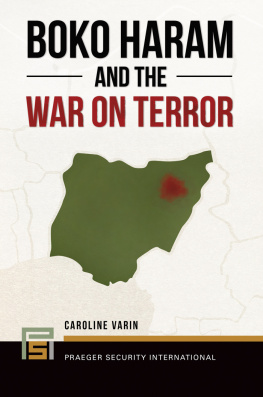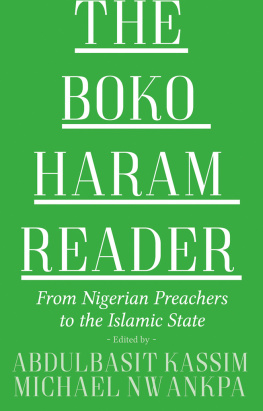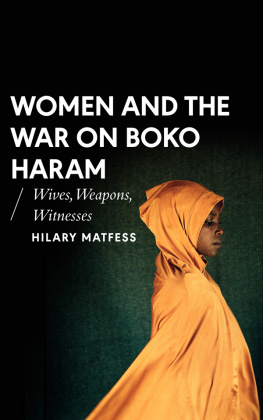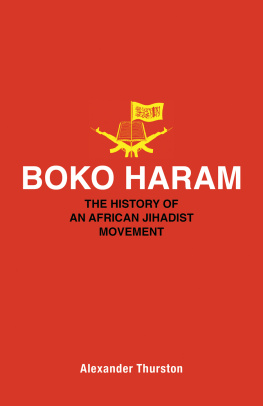Published by
World Scientific Publishing Europe Ltd.
57 Shelton Street, Covent Garden, London WC2H 9HE
Head office: 5 Toh Tuck Link, Singapore 596224
USA office: 27 Warren Street, Suite 401-402, Hackensack, NJ 07601
Library of Congress Cataloging-in-Publication Data
Names: Maszka, John, 1963 author.
Title: Al-Shabaab and Boko Haram : guerrilla insurgency or strategic terrorism? /
John Maszka (Al Ain Mens College, UAE).
Description: New Jersey : World Scientific, [2017] | Includes bibliographical references.
Identifiers: LCCN 2017027908 | ISBN 9781786343987 (hc : alk. paper)
Subjects: LCSH: Boko Haram. | Shabaab (Organization) | Insurgency--Africa. |
Guerrillas--Africa. | Terrorism--Africa. | Africa--Politics and government--1960
Classification: LCC DT30.5 .M2835 2017 | DDC 363.32509669--dc23
LC record available at https://lccn.loc.gov/2017027908
British Library Cataloguing-in-Publication Data
A catalogue record for this book is available from the British Library.
Copyright 2018 by World Scientific Publishing Europe Ltd.
All rights reserved. This book, or parts thereof, may not be reproduced in any form or by any means, electronic or mechanical, including photocopying, recording or any information storage and retrieval system now known or to be invented, without written permission from the Publisher.
For photocopying of material in this volume, please pay a copying fee through the Copyright Clearance Center, Inc., 222 Rosewood Drive, Danvers, MA 01923, USA. In this case permission to photocopy is not required from the publisher.
Desk Editors: Sundar Madhan/Koe Shi Ying
Typeset by Stallion Press
Email:
Printed in Singapore
Preface
How can you tell medical marijuana from ordinary marijuana? By its smell? By its taste? By the type of people who smoke it? By the people who sell it? By its potency? No matter how hard you try to tell the difference, you cant because marijuana is marijuana. There are different varieties, of course. But the only difference between ordinary marijuana and medical marijuana is the purpose for which it is used.
The very same thing can be said of violence. How can we distinguish between various types of violence such as crime, war, insurgency, and terrorism? By the perpetrator? By the victim(s)? By the perpetrators ideology or religion? By the type of weapons used or the extent of the carnage? As with marijuana, the only way to distinguish one form of violence from another is by the strategic objective of the actor. Terrorism is the use or threat of violence to coerce a political concession. Regardless of whether it involves bombs, guns, knives, an airplane (or a truck), violence is violence. If no political concession is demanded, it is not terrorism.
Why is this important? Because so much violence today is touted as terrorism when in fact it is something else altogether. This is especially true of extremist violence. Most of the violence that the media refers to as Islamic terrorism is neither Islamic nor terrorism. A great deal of it is geopolitical, not religious. Even much of the violence that is religious in nature is not terrorism because no political concession(s) are demanded. More often than not, this violence involves civil war, genocide, the mentally unstable or someone seeking their 10 minutes of fame. Very, very little of it can accurately be labeled as terrorism.
So how do we determine the strategic goal of an actor? We have to begin with a strategic analysis of the actor to understand its history, the socioeconomic and political context in which it emerged, and how this context has framed the actors choices and preferences. Only then can we begin to determine what the actor hopes to achieve.
This book investigates two of the deadliest organizations in Africa: al-Shabaab and Boko Haram. The U.S. State Department designated al-Shabaab, a terrorist organization in February 2008, and it likewise designated Boko Haram, a terrorist organization in November 2013. But are these two groups actually terrorist organizations? Or should they more accurately be labeled insurgent groups? The answer to this question is not as straightforward as it may seem. The first order of business is to clearly define what we mean by terrorist and what we understand an insurgent to be.
In the most generic sense, we can differentiate between conventional warfare which seeks to conquer the enemy and terrorism which aims to manipulate political change through terror (Ruby, 2002; Neumann and Smith, 2005). However, because the decision to employ terrorist violence is strategic, we can also distinguish between groups that employ terrorist violence as part of an overall strategy and those that rely solely on terrorist violence to achieve their goals. By employing this three-part typology, we are left with three basic categories of violence: (1) military violence intended to overthrow a regime, (2) terrorist violence employed along
Still, even with this simple trichotomy, the inquiry is not as straight-forward as it may appear because al-Shabaab and Boko Haram have both gone through a number of transitions in which their ideology and tactical operations have changed considerably. In the case of al-Shabaab, even its strategic goals appear to have changed. Therefore, we need more than a superficial understanding of these two organizations and what they hope to achieve through violence.
In this book, I employ a strategic analysis of al-Shabaab and Boko Haram. Strategic theory considers the utility of violence as a military strategy (Neumann and Smith, 2007). While most terrorism literature is concerned with why terrorist violence occurs or its causes, strategic theory seeks to examine how political actors define the circumstances around them and how they react to those circumstances to achieve their objectives (Smith, 1991, p. 17). By tracing the line of thinking of these two organizations, I strive to understand what their strategic objectives are, determine whether they have changed over the years, and measure how successful the groups use of violence has been toward the achievement of their strategic goals.
After tracing each groups ideological underpinnings back through their respective predecessors, I examine the various phases that each organization has transitioned through and determine what its strategic objective is and whether it has changed from one phase to another.
A component of this analysis is the theory of perception of the other (Garfinkel, 1952). Perception plays a huge role in both the decision to engage in terrorist violence and in the way target governments respond (Laqueur, 1977b; Crenshaw, 1981; Berry, 1987). Strategy is the use of ones resources toward the attainment of ones goals (Andrews and Roland, 1987). Therefore, how an actor perceives its own resources vis--vis the resources of another plays as large a role as the strategic goal itself. Furthermore, because both al-Shabaab and Boko Haram have adopted the





